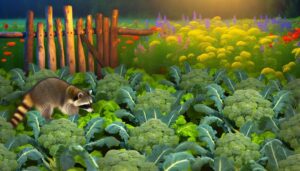Do Raccoons Live in Rainforests?
Yes, raccoons inhabit rainforest ecosystems in North, Central, and South America, including regions like Mexico, Panama, and Colombia. These adaptable mammals thrive in rainforest environments due to their omnivorous diet, which includes fruits, insects, and small animals.
They are skilled climbers, maneuvering the forest canopy effectively. Raccoons exhibit nocturnal behavior, reducing predation risks from animals such as jaguars and large birds of prey.
Despite facing threats from habitat destruction and climate change, their varied diet and opportunistic feeding behavior allow them to exploit numerous ecological niches. To appreciate these complex survival strategies, consider examining the intricacies of their behavior and adaptations further.
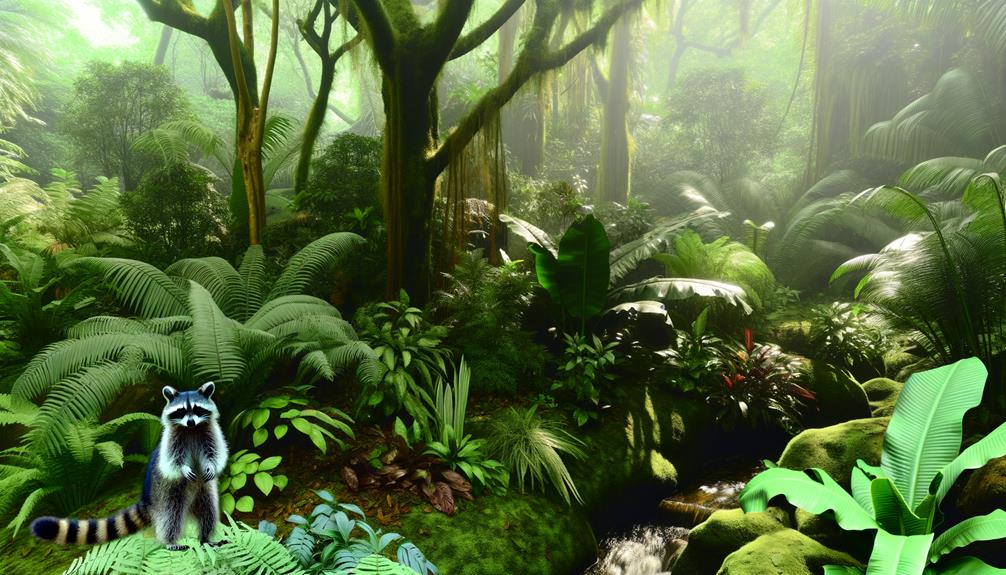
Key Takeaways
- Raccoons are found in rainforests, particularly in regions like Mexico, Panama, and Colombia.
- They adapt well to rainforest ecosystems due to their omnivorous diet and arboreal capabilities.
- Raccoons prefer rainforest areas near water sources, enhancing their survival chances.
- Nocturnal behavior helps raccoons avoid predators and reduce competition in rainforests.
- Conservation efforts aim to protect raccoon habitats in rainforests from threats like deforestation and climate change.
Raccoon Habitat Overview
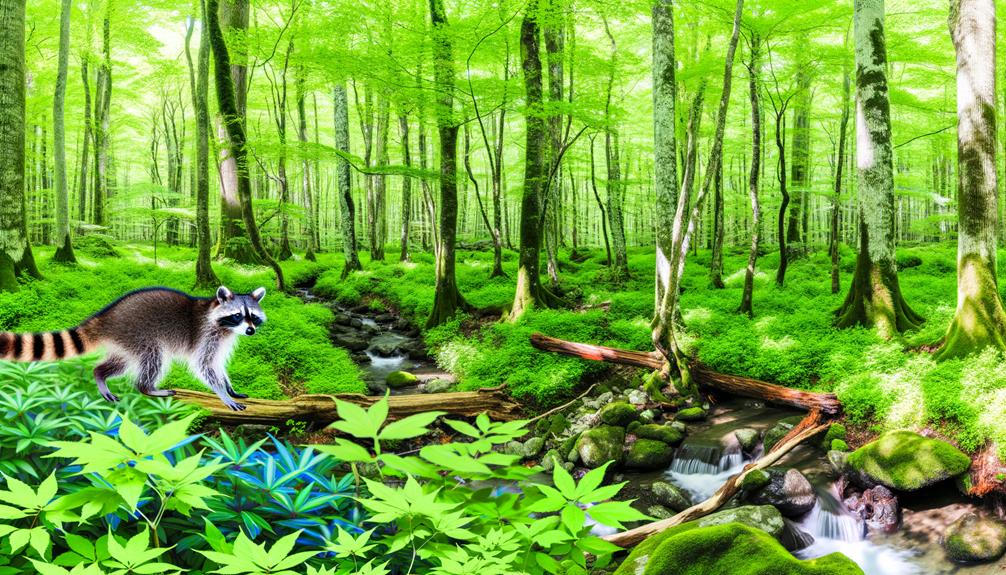
How do raccoons adapt to the diverse and complex ecosystems of the rainforest, especially regarding their habitat preferences and survival strategies?
Raccoons (Procyon lotor) demonstrate remarkable adaptability to various environments, including the rainforest.
In these dense, biodiverse habitats, raccoons prefer regions near water sources such as rivers and streams.
Their omnivorous diet allows them to exploit a wide range of food resources, including fruits, insects, and small animals.
Arboreal capabilities enable raccoons to navigate the forest canopy, accessing food and evading predators.
Additionally, their nocturnal behavior reduces competition and predation risks.
Raccoons utilize natural shelters like hollow trees and dense foliage for nesting, which provides protection from both climatic elements and potential threats.
This versatility underscores their successful adaptation to rainforest ecosystems.
Temperate Zone Adaptations
Raccoons exhibit a range of physiological and behavioral adaptations that enable them to thrive in temperate zones, where seasonal variations present unique challenges and opportunities. These adaptations are crucial for their survival and efficient resource utilization throughout the year.
- Fur Density Variability: Raccoons develop thicker fur in winter to insulate against cold temperatures, while shedding excess fur in summer to prevent overheating.
- Omnivorous Diet: Their ability to consume a diverse diet, from fruits and nuts to small animals and insects, guarantees food availability across seasons.
- Hibernation-Like States: Although not true hibernators, raccoons enter a state of torpor during extreme cold, reducing metabolic rates to conserve energy.
These adaptations showcase the raccoon's remarkable ability to navigate the fluctuating conditions of temperate environments.
Tropical Rainforest Characteristics
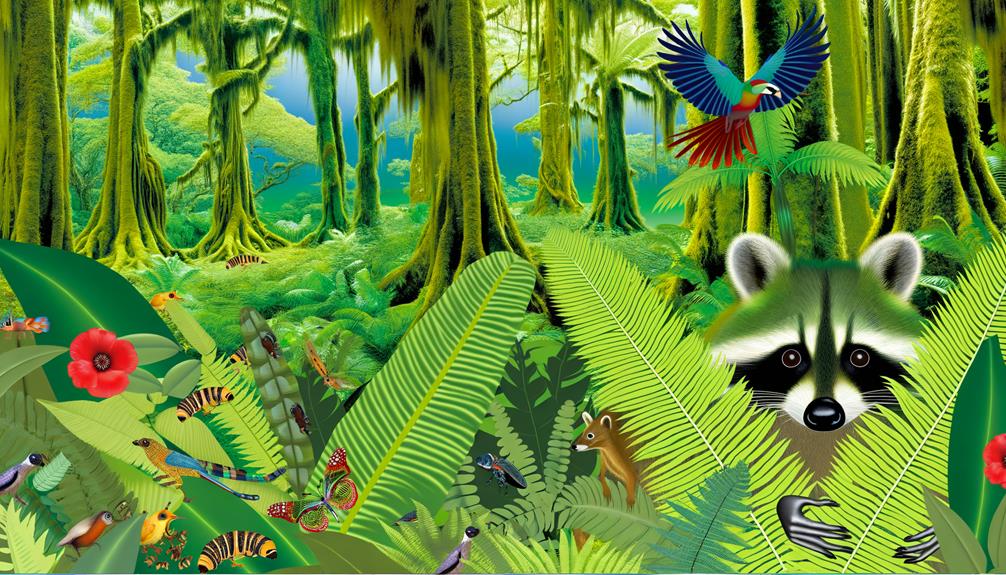
The tropical rainforest, characterized by high biodiversity and a consistently warm, humid climate, presents a unique and challenging environment for its inhabitants.
These ecosystems are typically found near the equator and receive substantial annual rainfall, often exceeding 200 centimeters.
The dense canopy layer limits sunlight penetration, fostering a multi-layered forest structure with distinct strata, including emergent, canopy, understory, and forest floor layers.
This vertical stratification supports diverse flora and fauna adapted to specific niches.
High humidity levels, averaging around 77-88%, and temperatures consistently between 20-25°C, create conditions that facilitate rapid decomposition and nutrient cycling.
The rainforest's complex web of life includes myriad plant species, insects, birds, mammals, and microorganisms, making it one of the most productive and diverse biomes on Earth.
Raccoon Geographic Distribution
In addition to their well-known presence in North America, raccoons have also been observed in various locations across Central and South America, including the tropical rainforests. Their geographic distribution demonstrates a remarkable adaptability to diverse environments. Notable regions where raccoons have been documented include:
- Mexico: Raccoons thrive in both urban and rural areas, including forested regions.
- Panama: Various ecosystems, including rainforests, provide suitable habitats for raccoons.
- Colombia: The species has adapted to local climatic conditions, including tropical rainforests.
These observations underscore the raccoon's ability to exploit a range of habitats, from temperate woodlands to humid tropical forests. This distribution is a demonstration of their ecological flexibility and resilience in varying environmental conditions.
Diet and Food Sources
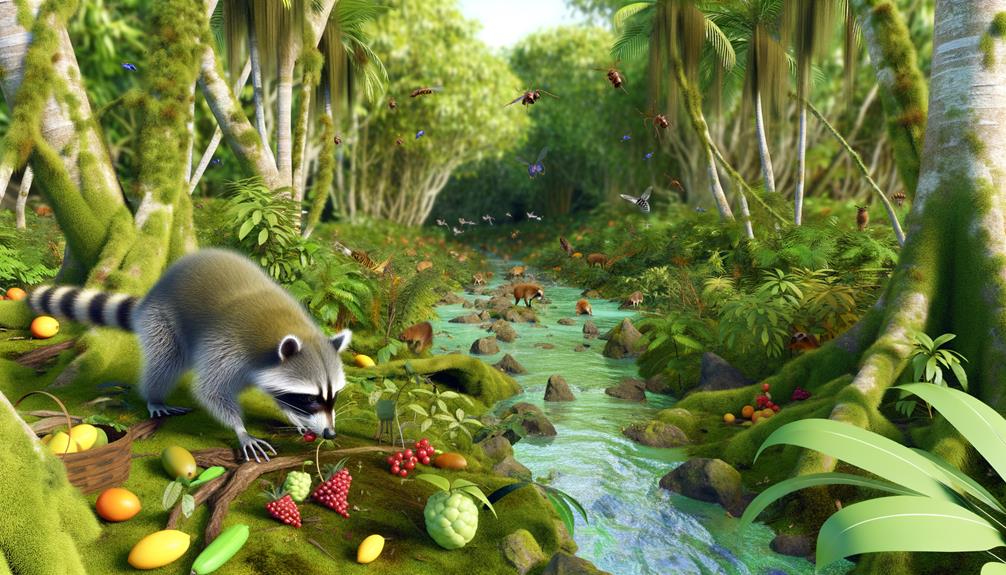
Numerous studies have documented that raccoons exhibit an omnivorous diet, consuming a diverse array of food sources including fruits, insects, small vertebrates, and human refuse. In rainforest ecosystems, their diet is influenced by the availability of seasonal and spatial resources. This dietary flexibility allows raccoons to exploit a variety of ecological niches.
| Food Source | Examples |
|---|---|
| Fruits | Berries, tropical fruits |
| Insects | Beetles, ants |
| Small Vertebrates | Frogs, birds |
| Human Refuse | Leftover food, garbage |
Such dietary adaptability is vital for their survival in the dynamic rainforest environment, where food availability can fluctuate significantly. Raccoons' opportunistic feeding behavior underscores their ability to thrive in diverse habitats, ranging from urban areas to dense rainforests.
Behavioral Adaptability
Raccoons exhibit remarkable behavioral adaptability, enabling their survival in both urban and wild habitats.
This adaptability is particularly evident in their versatile diet and advanced foraging skills, which allow them to exploit a wide range of food sources.
Their ability to adjust their behaviors based on environmental conditions highlights their ecological plasticity.
Urban and Wild Habitats
Behavioral adaptability enables raccoons to thrive in both urban and wild habitats, demonstrating their remarkable capacity to modify behaviors in response to diverse environmental challenges.
This adaptability is evident in their ability to:
- Utilize a variety of shelters: Raccoons can inhabit tree hollows, burrows, and even attics and chimneys in urban areas.
- Exploit diverse food sources: They exhibit flexibility in diet, allowing them to forage in both natural ecosystems and human environments.
- Navigate varied landscapes: Raccoons are skilled climbers and swimmers, facilitating movement across forests, wetlands, and cityscapes.
These behavioral traits underscore their survival and reproductive success in vastly different habitats, reinforcing the ecological versatility that characterizes the species. Understanding these adaptive strategies is essential for appreciating their ecological impact.
Diet and Foraging Skills
The dietary versatility of raccoons, encompassing both omnivorous tendencies and opportunistic foraging behaviors, greatly contributes to their success in a range of environments.
In the rainforest, raccoons exploit a diverse array of food sources, including fruits, nuts, insects, small vertebrates, and aquatic organisms. Their dexterous forepaws facilitate the extraction of food from intricate environments, demonstrating remarkable adaptability.
Additionally, raccoons exhibit nocturnal foraging habits, which reduce competition with diurnal species and enhance their survival prospects. This behavioral adaptability allows them to efficiently exploit temporary food abundances and navigate fluctuating resource availability.
Consequently, raccoons can sustain themselves in the complex and dynamic ecosystems of rainforests, highlighting their exceptional ecological plasticity and foraging acumen.
Predators and Threats
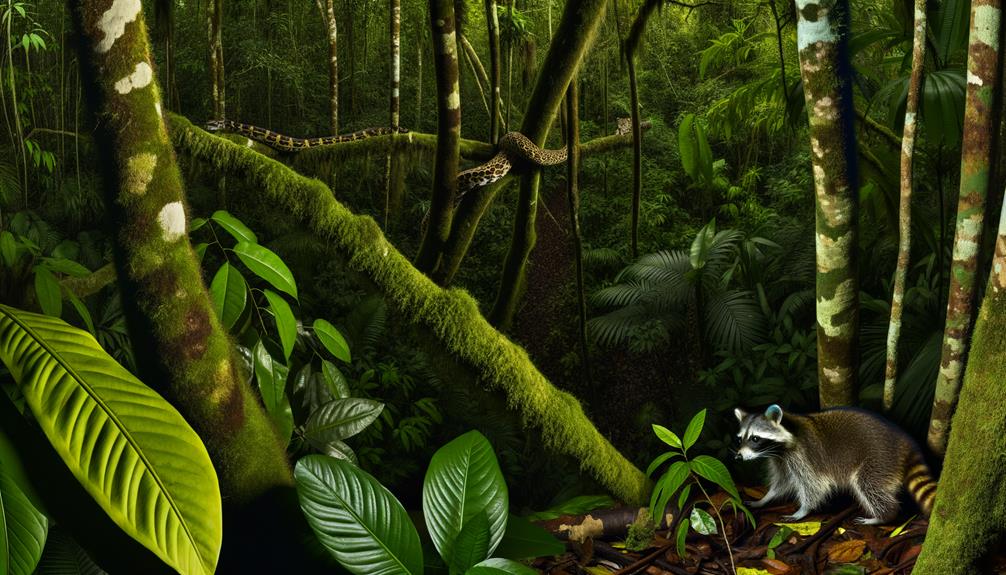
Raccoons in the rainforest face a variety of natural predators, including large birds of prey, jaguars, and snakes, which impact their survival rates to a great extent.
Additionally, environmental threats such as deforestation and climate change exacerbate the challenges these animals encounter by disrupting their habitats and food sources.
Understanding these factors is essential for developing effective conservation strategies tailored to the unique ecosystem of the rainforest.
Natural Predators Overview
In the dense and diverse ecosystem of rainforests, raccoons face a range of natural predators that greatly influence their behavior and survival strategies. These predators play a pivotal role in maintaining the ecological balance within these habitats.
Key predators include:
- Jaguars: As apex predators, jaguars prey on raccoons, utilizing their powerful jaws and stealth to capture them.
- Large Birds of Prey: Species such as harpy eagles can snatch raccoons from trees, leveraging their keen eyesight and strong talons.
- Snakes: Large constrictor snakes, like boas, pose a significant threat by ambushing raccoons and employing constriction to subdue them.
Understanding these predator-prey dynamics is essential for comprehending the broader ecological roles raccoons play in rainforest environments.
Environmental Threats Analysis
Beyond natural predators, raccoons in the rainforest contend with various environmental threats that greatly impact their survival and behavior. Habitat destruction, primarily due to deforestation and agricultural expansion, markedly reduces their living spaces and food sources.
Additionally, climate change alters rainfall patterns and temperatures, disrupting the delicate balance of the rainforest ecosystem. Pollution, including chemical runoff and plastic waste, further jeopardizes raccoon health by contaminating water and food supplies.
Human activities such as poaching and road construction also pose direct threats, leading to increased mortality rates. These environmental pressures necessitate adaptive behaviors and may force raccoons to migrate to less suitable habitats, thereby affecting their overall population dynamics and genetic diversity.
Raccoon Species Variations
Among the various species of raccoons inhabiting the rainforest, notable differences can be observed in their physical characteristics, behaviors, and ecological roles. These variations are crucial for understanding how each species adapts to its environment and maintains ecosystem balance.
Key distinctions include:
- Physical Characteristics: Variations in fur coloration, size, and tail patterns are prevalent among different raccoon species, aiding in camouflage and thermoregulation.
- Behavioral Traits: Differences in foraging habits, nocturnal activity levels, and social structures help each species to optimize resource utilization and reduce interspecies competition.
- Ecological Roles: Divergent dietary preferences and habitat use influence the roles raccoons play in seed dispersal, insect population control, and as prey for larger predators.
Understanding these differences is crucial for conservation efforts and ecological studies.
Evidence in Rainforests
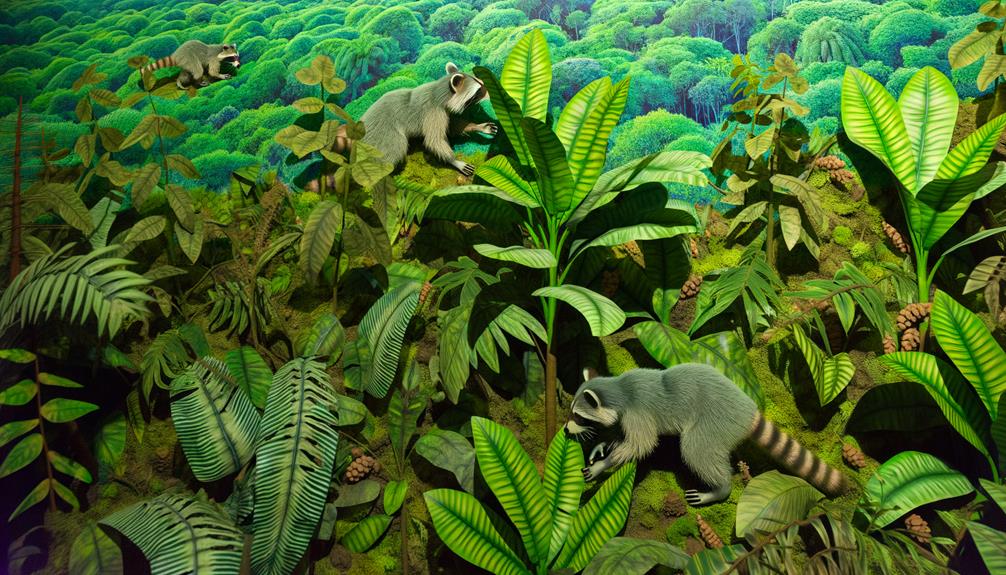
Extensive field research and observational studies provide substantial evidence of raccoon presence and activity within various rainforest ecosystems. Researchers have documented raccoons in both Neotropical and temperate rainforests, noting their adaptability to diverse environmental conditions.
Evidence Type | Location
————- | ——–
Footprints | Amazon Rainforest
Camera Traps | Costa Rican Rainforest
Foraging Signs | Southeast Asian Rainforests
These findings reveal that raccoons exhibit nocturnal behavior and utilize a variety of food sources, from fruits to small vertebrates, within these habitats. Camera trap data further supports their widespread distribution and adaptability, confirming sightings in regions traditionally not associated with raccoon habitation. This empirical data underscores the ecological versatility of raccoons and their successful integration into rainforest ecosystems.
Conservation and Future Trends
The conservation of raccoons in rainforest ecosystems requires thorough habitat preservation efforts to mitigate ongoing threats to their survival. These threats include deforestation, climate change, and human encroachment, which collectively disrupt the ecological balance.
Future conservation strategies must focus on sustainable practices, enhanced legal protections, and community engagement to guarantee the long-term viability of raccoon populations in these biodiverse regions.
Habitat Preservation Efforts
How are current habitat preservation efforts shaping the future conservation strategies for raccoons in the rainforest?
Current initiatives are crucial, focusing on maintaining and restoring critical habitats. Strategies are evolving through scientific research and community engagement.
Protected Areas: Establishing and managing protected zones safeguards raccoons have safe, undisturbed environments.
Reforestation Projects: Replanting native flora assists in restoring ecosystems that support raccoon populations.
Community Involvement: Educating and involving local communities fosters sustainable practices that benefit both humans and wildlife.
These efforts collectively aim to mitigate habitat loss and secure raccoon populations thrive. By integrating scientific methodologies and local cooperation, future conservation strategies will be more resilient, adaptive, and effective in preserving rainforest habitats.
Threats to Survival
Despite ongoing preservation efforts, raccoons in the rainforest face numerous hazards to their survival. These include habitat fragmentation, climate change, and human encroachment.
Habitat fragmentation, resulting from deforestation and agricultural expansion, disrupts raccoon populations by reducing their natural habitat and isolating groups.
Climate change exacerbates these issues by altering precipitation patterns and temperature regimes, impacting food availability and ecosystem stability.
Human encroachment, through urbanization and infrastructure development, further displaces raccoons and increases the risk of human-wildlife conflicts.
Additionally, pollution and the introduction of non-native species can disrupt the ecological balance, posing indirect threats to raccoon populations.
These multifaceted threats necessitate thorough conservation measures to guarantee the continued survival of raccoons in rainforest habitats.
Future Conservation Strategies
To secure the long-term survival of raccoons in rainforest ecosystems, it is crucial to develop and implement innovative conservation strategies that address both current and emerging threats. Effective conservation requires a multi-faceted approach:
- Habitat Preservation: Safeguarding critical habitats through legal protection and sustainable land management practices.
- Research and Monitoring: Conducting ongoing studies to understand raccoon behaviors, population dynamics, and ecological roles.
- Community Engagement: Involving local communities in conservation efforts through education and sustainable livelihoods to reduce human-wildlife conflict.
These strategies collectively enhance our ability to protect raccoons and maintain biodiversity in rainforest environments. By integrating scientific research, policy development, and community participation, we can create resilient frameworks that secure the persistence of raccoons and other essential species.
Conclusion
In examining the habitats of Procyon lotor, the raccoon, it becomes apparent that although primarily adapted to temperate zones, their presence in tropical rainforests remains an enigma akin to Schrödinger's cat.
The species' adaptability allows for a diverse diet and survival strategies, yet empirical evidence of their sustained presence in rainforests is limited.
Conservation efforts and future ecological studies must address these uncertainties to fully understand the raccoon's ecological niche and potential range expansion amidst environmental changes.





